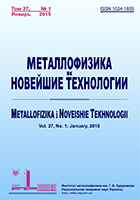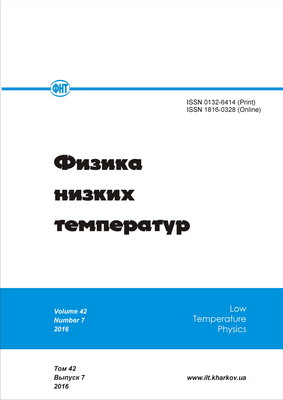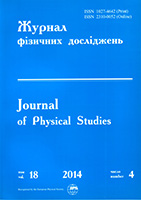 Книжкові видання та компакт-диски  Журнали та продовжувані видання  Автореферати дисертацій  Реферативна база даних  Наукова періодика України  Тематичний навігатор  Авторитетний файл імен осіб
 |
Для швидкої роботи та реалізації всіх функціональних можливостей пошукової системи використовуйте браузер
"Mozilla Firefox" |
|
|
Повнотекстовий пошук
Пошуковий запит: (<.>A=Bekenov L$<.>) |
Загальна кількість знайдених документів : 6
Представлено документи з 1 до 6
|
| 1. |

Bekenov L. V.
Electronic Structure and X-Ray Magnetic Circular Dichroism in (Zn, T)O (T = V, Fe, Co) Diluted Magnetic Semiconductors [Електронний ресурс] / L. V. Bekenov, D. V. Mazur, V. N. Antonov, L. P. Germash, A. Ernst // Металлофизика и новейшие технологии. - 2013. - Т. 35, № 1. - С. 1-17. - Режим доступу: http://nbuv.gov.ua/UJRN/MPhNT_2013_35_1_3
The electronic structure of (Ti,Mn)O2 diluted magnetic semiconductors was investigated theoretically from first principles using the fully relativistic Dirac linear muffin-tin orbital band structure method. The electronic structure was obtained with the local spin-density approximation taking into account strong Coulomb correlations in the frame of the LSDA + U approximation. The x-ray absorption spectra and x-ray magnetic circular dichroism spectra at the Mn and Ti L2,3 and O K edges were investigated theoretically from first principles. The origin of the XMCD spectra in these compounds was examined. The calculated results are compared with available experimental data.Вивчено електронні та магнітні властивості сполук T2AlC (T = Ti та Cr) в межах теорії функціонала густини з використанням узагальненого градієнтного наближення (GGA) з урахуванням сильних кулонівських кореляцій (GGA + U), розраховуючи зонну структуру в формалізмі повністю релятивістського спін-поляризованого методу діраківських лінійних МТ-орбіталей (LMTO). Теоретично досліджено рентгенівські спектри поглинання та рентгенівський магнітний циркулярний дихроїзм (XMCD) на Cr L2,3 і Cr, Ti, C K краях поглинання. Результати розрахунків добре узгоджуються з експериментальними даними. Досліджено вплив електричного квадрупольного E2 і магнітного дипольного M1 переходів на Cr K краю поглинання.
| | 2. |

Antonov V. N.
Electronic structure and x-ray magnetic circular dichroism in the Mn3CuN perovskite [Електронний ресурс] / V. N. Antonov, L. V. Bekenov // Физика низких температур. - 2014. - Т. 40, № 7. - С. 825-834. - Режим доступу: http://nbuv.gov.ua/UJRN/PhNT_2014_40_7_12
The electronic structure and x-ray magnetic circular dichroism (XMCD) spectra of US, USe, and UTe are investigated theoretically from first principles, using the fully relativistic Dirac LMTO band structure method. The electronic structure is obtained with the local spin-density approximation (LSDA), as well as with a generalization of the LSDA+U method which takes into account that in the presence of spin - orbit coupling the occupation matrix of localized electrons becomes non-diagonal in spin indexes. The origin of the XMCD spectra in the compounds is examined.The electronic structure and x-ray magnetic circular dichroism (XMCD) spectra of the Heusler alloy Co2FeSi were investigated theoretically from first principles, using the fully relativistic Dirac linear MT-orbital band structure method. Densities of valence states, orbital and spin magnetic moments as well as polarization of the electronic states at the Fermi level are analyzed and discussed. The origin of the XMCD spectra in the Co2FeSi compound is examined. The calculated results are compared with available experimental data.На підставі розрахунків повністю релятивістським діраківським лінійним методом МТ-орбіталей теоретично з перших принципів досліджено електронну структуру розбавлених магнітних напівпровідників (Ge,Mn)Te. Розрахунки проведено як у наближенні локальної спінової густини (LSDA), так і методом LSDA+U. Теоретично з перших принципів досліджено Mn <$E L sub 2,3> спектри рентгенівського магнітного циркулярного дихроїзму (РМЦД) у сполуці (Ge,Mn)Te. Вивчено походження спектрів РМЦД. Результати розрахунків порівняно з наявними експериментальними даними.The electronic and magnetic structures of Mn3CuN are investigated theoretically from first principles using the fully relativistic Dirac LMTO band structure method. Mn3CuN possesses a magnetic phase transition at Tc = 143 K from a high temperature paramagnetic phase to a low temperature ferromagnetic one with a noncollinear magnetic structure. The transition is accompanied by a structural change from the cubic to the tetragonal lattice. In low temperature phase two Cu moments and two Mn moments (Mn2 and Mn3) ferromagnetically align along the c axis while other four Mn1 magnetic moments are canted from the c axis to [111] direction by angle <$E THETA~=~symbol С~76,2>. The x-ray absorption spectra and x-ray magnetic circular dichroism (XMCD) spectra of Mn3CuN are investigated theoretically from first principles. The origin of the XMCD spectra in the Mn3CuN compound is examined. The calculated results are compared with the experimental data.A systematic electronic structure study of <$E {A sub 2 CrB prime O sub 6}> (A = Ca, Sr; <$E roman {B prime~=~W,~Re}>, and Os) has been performed by employing the local spin-density approximation (LSDA) as well as the GGA and LSDA + U methods using the fully relativistic spin-polarized Dirac linear muffin-tin orbital band-structure method. We investigated the effects of the subtle interplay among the spin-orbit coupling, electron correlations, and lattice distortion on the electronic structure of the double perovskites. First principles calculations predict that Sr2CrOsO6 is (before considering spin-orbit coupling) actually a ferrimagnetic semimetal with precisely compensating spin moments, or spin-asymmetric compensated semimetallic ferrimagnet in which the electrons and holes are each fully polarized and have opposite spin directions, in spite of a zero net moment and hence no macroscopic magnetic field. Spin-orbit coupling degrades this by giving a nonzero total moment, but the band structure is little changed. Therefore, the observed saturation moment of ferrimagnetic Sr2CrOsO6 is entirely due to spin-orbit coupling. The x-ray absorption spectra and x-ray magnetic circular dichroism at the W, Re, Os, and Cr L2,3, and Cr and O K edges were investigated theoretically from first principles. A qualitative explanation of the XMCD spectra shape is provided by the analysis of the corresponding selection rules, orbital character and occupation numbers of individual orbitals. The calculated results are in good agreement with experimental data. The complex fine structure of the Cr L2,3 XAS in Sr2CrWO6 and Sr2CrReO6 was found to be not compatible with a pure Cr<^>3+ valency state. The interpretation demands mixed valent states. We found that possible oxygen vacancies lead to a mixed valency at the Cr site, double peak structure at the Cr L2,3 edges and reduce the saturation magnetization in Sr2CrWO6 and Sr2CrReO6.
| | 3. |

Bekenov L. V.
Electronic structure and x-ray magnetic circular dichroism of Mn-doped TiO2 [Електронний ресурс] / L. V. Bekenov, V. N. Antonov // Физика низких температур. - 2015. - Т. 41, № 12. - С. 1254-1260. - Режим доступу: http://nbuv.gov.ua/UJRN/PhNT_2015_41_12_7
The electronic structure of (Ti,Mn)O2 diluted magnetic semiconductors was investigated theoretically from first principles using the fully relativistic Dirac linear muffin-tin orbital band structure method. The electronic structure was obtained with the local spin-density approximation taking into account strong Coulomb correlations in the frame of the LSDA + U approximation. The x-ray absorption spectra and x-ray magnetic circular dichroism spectra at the Mn and Ti L2,3 and O K edges were investigated theoretically from first principles. The origin of the XMCD spectra in these compounds was examined. The calculated results are compared with available experimental data.Вивчено електронні та магнітні властивості сполук T2AlC (T = Ti та Cr) в межах теорії функціонала густини з використанням узагальненого градієнтного наближення (GGA) з урахуванням сильних кулонівських кореляцій (GGA + U), розраховуючи зонну структуру в формалізмі повністю релятивістського спін-поляризованого методу діраківських лінійних МТ-орбіталей (LMTO). Теоретично досліджено рентгенівські спектри поглинання та рентгенівський магнітний циркулярний дихроїзм (XMCD) на Cr L2,3 і Cr, Ti, C K краях поглинання. Результати розрахунків добре узгоджуються з експериментальними даними. Досліджено вплив електричного квадрупольного E2 і магнітного дипольного M1 переходів на Cr K краю поглинання.
| | 4. |

Antonov V. N.
Electronic structure and x-ray magnetic circular dichroism in A2CrB′O6 (A = Ca, Sr; B′ = W, Re, and Os) oxides [Електронний ресурс] / V. N. Antonov, L. V. Bekenov // Физика низких температур. - 2017. - Т. 43, № 5. - С. 724-737. - Режим доступу: http://nbuv.gov.ua/UJRN/PhNT_2017_43_5_10
The electronic structure and x-ray magnetic circular dichroism (XMCD) spectra of US, USe, and UTe are investigated theoretically from first principles, using the fully relativistic Dirac LMTO band structure method. The electronic structure is obtained with the local spin-density approximation (LSDA), as well as with a generalization of the LSDA+U method which takes into account that in the presence of spin - orbit coupling the occupation matrix of localized electrons becomes non-diagonal in spin indexes. The origin of the XMCD spectra in the compounds is examined.The electronic structure and x-ray magnetic circular dichroism (XMCD) spectra of the Heusler alloy Co2FeSi were investigated theoretically from first principles, using the fully relativistic Dirac linear MT-orbital band structure method. Densities of valence states, orbital and spin magnetic moments as well as polarization of the electronic states at the Fermi level are analyzed and discussed. The origin of the XMCD spectra in the Co2FeSi compound is examined. The calculated results are compared with available experimental data.На підставі розрахунків повністю релятивістським діраківським лінійним методом МТ-орбіталей теоретично з перших принципів досліджено електронну структуру розбавлених магнітних напівпровідників (Ge,Mn)Te. Розрахунки проведено як у наближенні локальної спінової густини (LSDA), так і методом LSDA+U. Теоретично з перших принципів досліджено Mn <$E L sub 2,3> спектри рентгенівського магнітного циркулярного дихроїзму (РМЦД) у сполуці (Ge,Mn)Te. Вивчено походження спектрів РМЦД. Результати розрахунків порівняно з наявними експериментальними даними.The electronic and magnetic structures of Mn3CuN are investigated theoretically from first principles using the fully relativistic Dirac LMTO band structure method. Mn3CuN possesses a magnetic phase transition at Tc = 143 K from a high temperature paramagnetic phase to a low temperature ferromagnetic one with a noncollinear magnetic structure. The transition is accompanied by a structural change from the cubic to the tetragonal lattice. In low temperature phase two Cu moments and two Mn moments (Mn2 and Mn3) ferromagnetically align along the c axis while other four Mn1 magnetic moments are canted from the c axis to [111] direction by angle <$E THETA~=~symbol С~76,2>. The x-ray absorption spectra and x-ray magnetic circular dichroism (XMCD) spectra of Mn3CuN are investigated theoretically from first principles. The origin of the XMCD spectra in the Mn3CuN compound is examined. The calculated results are compared with the experimental data.A systematic electronic structure study of <$E {A sub 2 CrB prime O sub 6}> (A = Ca, Sr; <$E roman {B prime~=~W,~Re}>, and Os) has been performed by employing the local spin-density approximation (LSDA) as well as the GGA and LSDA + U methods using the fully relativistic spin-polarized Dirac linear muffin-tin orbital band-structure method. We investigated the effects of the subtle interplay among the spin-orbit coupling, electron correlations, and lattice distortion on the electronic structure of the double perovskites. First principles calculations predict that Sr2CrOsO6 is (before considering spin-orbit coupling) actually a ferrimagnetic semimetal with precisely compensating spin moments, or spin-asymmetric compensated semimetallic ferrimagnet in which the electrons and holes are each fully polarized and have opposite spin directions, in spite of a zero net moment and hence no macroscopic magnetic field. Spin-orbit coupling degrades this by giving a nonzero total moment, but the band structure is little changed. Therefore, the observed saturation moment of ferrimagnetic Sr2CrOsO6 is entirely due to spin-orbit coupling. The x-ray absorption spectra and x-ray magnetic circular dichroism at the W, Re, Os, and Cr L2,3, and Cr and O K edges were investigated theoretically from first principles. A qualitative explanation of the XMCD spectra shape is provided by the analysis of the corresponding selection rules, orbital character and occupation numbers of individual orbitals. The calculated results are in good agreement with experimental data. The complex fine structure of the Cr L2,3 XAS in Sr2CrWO6 and Sr2CrReO6 was found to be not compatible with a pure Cr<^>3+ valency state. The interpretation demands mixed valent states. We found that possible oxygen vacancies lead to a mixed valency at the Cr site, double peak structure at the Cr L2,3 edges and reduce the saturation magnetization in Sr2CrWO6 and Sr2CrReO6.
| | 5. |

Shcherba I. D.
Electronic structure and X-ray spectroscopic properties of the HfFe2Si2 compound [Електронний ресурс] / I. D. Shcherba, V. N. Antonov, O. V. Zhak, L. V. Bekenov, M. V. Kovalska, H. Noga, D. Uskokovic, B. M. Yatcyk // Журнал фізичних досліджень. - 2019. - Т. 23, Число 2. - С. 2301-1-2301-7. - Режим доступу: http://nbuv.gov.ua/UJRN/jphd_2019_23_2_4
| | 6. |

Antonov V. N.
Electronic structure and physical properties of hybrid heterostructures Sr2CrOsO6/BaTiO3 [Електронний ресурс] / V. N. Antonov, L. V. Bekenov // Фізика низьких температур. - 2021. - Т. 47, Вип. 7. - С. 613-625. - Режим доступу: http://nbuv.gov.ua/UJRN/PhNT_2021_47_7_7
Наведено електронні спектри та магнітні властивості гібридних гетероструктур, що поєднують феромагнітний подвійний перовськіт Sr2CrOsO6 (SCOsO) і сегнетоелектрик BaTiO3 (BTO), які розраховано в підході GGA із використанням повністю релятивістського спінополяризованого методу LMTO Дірака. Структуру електронних смуг вивчено в оксидах BTO та SCOsO, а також у гетероструктурах SCOsO/BTO із різними суперелементами: (<$E 1~times~1~times~1>) одношарових, (<$E 2~times~2~times~1>) і (<$E 1~times~1~times~2>) SCOsO/BTO гетероструктур. Оптичні та магнітооптичні спектри чистих оксидів BTO та SCOsO, а також SCOsO/BTO гетероструктур досліджено теоретично та порівняно з доступними експериментальними даними. Теоретично досліджено спектри специфічного поглинання рентгенівських променів, а також рентгенівський магнітний круговий дихроїзм на L2, 3 ребрах Ti, Ba та Os у SCOsO/BTO гетероструктурах. Виявлено добру згоду з експериментальними спектрами.
|
|
|










 Пам`ятка користувача
Пам`ятка користувача